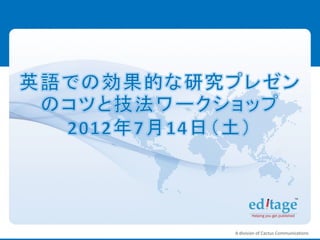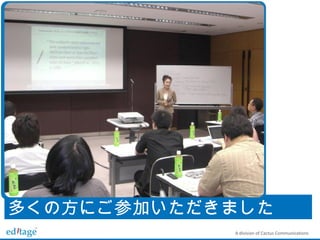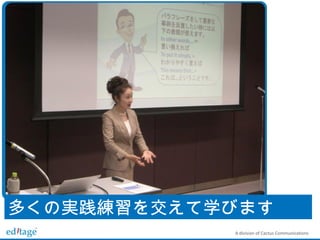1 of 4
Downloaded 10 times




Ad
Recommended
The power of digital assessment
The power of digital assessmentJay Ashcroft
?
The document discusses the evolution of digital assessment between 2000 and 2015, highlighting the challenges faced by schools due to poor technology use, resulting in high workloads and disengaged learners. It emphasizes the effectiveness of digitizing assessments, showing a significant increase in independent learning and student engagement through improved interaction. The author encourages schools to adopt digital assessment methods to enhance the educational experience.What Happens at School Stays on YouTube
What Happens at School Stays on YouTubePaul Brown
?
The document emphasizes the importance of understanding digital footprints and privacy on social media, warning that online actions can have lasting consequences. It encourages individuals to post responsibly, treat mistakes as learning opportunities, and to foster a supportive community by being an upstander. Additionally, it highlights the increasing role of social media in professional networking and recruitment.Sleep Hacks: How to Sleep Better
Sleep Hacks: How to Sleep BetterScott Britton
?
The document presents practical sleep hacks curated by Scott Britton, emphasizing the importance of various factors such as diet, environment, breathing, and consistency in achieving better sleep. Strategies include limiting caffeine intake, creating a conducive sleeping environment, maintaining a consistent sleep schedule, and using smart alarms to optimize sleep cycles. Testimonials from individuals who have implemented these hacks highlight significant improvements in their sleep quality and overall well-being.The Creative Classroom
The Creative ClassroomJohn Spencer
?
Despite the myth of "digital natives," most of my students have very little experience using technology as anything more than a consumer device. It doesn't have to be this way. By using the design thinking cycle, teachers can foster creative thinking in every content area.[Editage Seminar] Common language mistakes made by Japanese authors and essen...
[Editage Seminar] Common language mistakes made by Japanese authors and essen...英文校正エディテージ
?
This document summarizes a presentation given by Yukti Bharwani on common mistakes made by Japanese authors when writing research papers in English for publication. The presentation covers mistakes made in various sections of research papers like titles, keywords, cover letters, introductions, methods, results, discussions, and references. It provides tips to avoid these mistakes by following best practices in scientific writing. The presentation emphasizes understanding the perspective of journal editors and peer reviewers as the main audience for the paper.Checklist to avoid accidental plagiarism
Checklist to avoid accidental plagiarism英文校正エディテージ
?
The document provides a 10-point checklist for avoiding accidental plagiarism when writing manuscripts. It advises acknowledging the works of others, using quotation marks for verbatim text, keeping verbatim text to a minimum, rewriting content from previous studies in one's own words, citing sources, mentioning if the paper was previously presented, following ideas from previous studies with one's own interpretation, using plagiarism detection software, and emphasizing novelty in the cover letter.リズ?ウェイガー氏 ワークショップ 12月4日(火)东京?日本教育会馆 第二会议室
リズ?ウェイガー氏 ワークショップ 12月4日(火)东京?日本教育会馆 第二会议室 英文校正エディテージ
?
学会関係者?ジャーナル編集者の方対象!
12月4日(火)東京?日本教育会館にて、「今、日本の学会に求めらる学術出版の価値と倫理」と題した無料のセミナーをおこないます。講師はフリーのメディカルライター?編集者として活躍するリズ?ウェイガー氏です。
お申込みはこちらから→www.ej-labo.jp/jonvoeguh-13/#_13 査読コメントに回答する时の、3つの黄金律
査読コメントに回答する时の、3つの黄金律英文校正エディテージ
?
査読者やジャーナル编集者からのコメントは元来、执笔者の论文の质を高めることを目的とします。査読者のコメントに返答する际は、3つの黄金律に従いましょう。研究成果の発表に効果的な図表の使い方
研究成果の発表に効果的な図表の使い方英文校正エディテージ
?
様々な研究やジャーナルのガイドライン、そして科学関连の执笔に関する论説では、论文の质を上げるためには図表やグラフが重要な役割を担うと断言しています。この记事では図表の効果的な使い方に不可欠なガイドラインを绍介します。优れたタイトルとアブストラクト、适切なキーワード选び
优れたタイトルとアブストラクト、适切なキーワード选び英文校正エディテージ
?
タイトル、アブストラクト、キーワードは研究発表において中心的な役割を担います。これら无しでは、ほとんどの论文が全く読まれなかったり、兴味を持つ読者によって见つけられることさえないかもしれません。効果的な论文构成:论文を通して価値あるアイデアを伝える方法
効果的な论文构成:论文を通して価値あるアイデアを伝える方法 英文校正エディテージ
?
ジャーナル投稿の目的は、研究内容を効果的に読者に伝え、问题を手近にとるように理解を促すことです。最も大切なメッセージを読者がきちんと把握できるようにするためには、どのような论文构成が効果的なのでしょうか。インパクトファクターとジャーナルの名声を评価するその他の指标
インパクトファクターとジャーナルの名声を评価するその他の指标英文校正エディテージ
?
「インパクトファクター」という指标について、これまで耳にしたことがないという研究者はおそらくいないでしょう。しかし、インパクトファクターについてはあまり知られていない事実もあります。ジャーナルの质を测るための指标は他にも出てきています。Publication Schedule,論文 リジェクト,英語論文校正,英語論文,英語論文執筆,英文校正,英文校閲,英文添削,ネイティブチェック,英文チ...
Publication Schedule,論文 リジェクト,英語論文校正,英語論文,英語論文執筆,英文校正,英文校閲,英文添削,ネイティブチェック,英文チ...英文校正エディテージ
?
自分の研究を最善の方法で、适切な対象読者に伝えてくれる査読付きジャーナルを选ぶことがとても重要です。最善のジャーナルの选び方をチェックリストでまとめました。论文出版スケジュールの立て方
论文出版スケジュールの立て方英文校正エディテージ
?
ジャーナル出版において、リジェクトされるのは全く珍しいことではありません。论文出版の问题は「出版されるかどうか」ではなく「いつ出版されるか」です。リジェクトを想定に入れた上で、论文出版スケジュールを利用して首尾よく準备しましょう。ジャーナルが论文をリジェクトする最も一般的な理由
ジャーナルが论文をリジェクトする最も一般的な理由英文校正エディテージ
?
ジャーナルが论文をリジェクトする理由について、いくつかの査読付き研究论文について调査报告がされています。论文を受理しない最も一般的な理由とは何でしょうか。サラミ法,salami slicing,英文校正,英文校閲,英文添削,ネイティブチェック,英文チェック,プルーフリーディング,英語添削
サラミ法,salami slicing,英文校正,英文校閲,英文添削,ネイティブチェック,英文チェック,プルーフリーディング,英語添削英文校正エディテージ
?
査読者は论文を査定し、ジャーナル侧にコメントを送りますが、その论文を受理すべきかどうかという决定は下しません。出版可否の最终决定はジャーナル编集者によって行われます。「サラミ法」に隠れた危険:出版の量ではなく质を重视する
「サラミ法」に隠れた危険:出版の量ではなく质を重视する英文校正エディテージ
?
研究论文は、研究成果の内容を复数に分割して执笔投稿するよりも1本で包括的な研究内容を取り上げている场合にジャーナル掲载の可能性が高まります。「サラミ法」行為とその危険性について解説しています。出版?报告バイアスと研究発表への影响
出版?报告バイアスと研究発表への影响英文校正エディテージ
?
出版バイアスの実例がいくつか报告されています。どのようなバイアスの种类が存在するのか、また论文を执笔する际にはどのように対処すればよいのかを取り上げます。効果的な文献検索と最新论文の情报を入手する秘诀
効果的な文献検索と最新论文の情报を入手する秘诀 英文校正エディテージ
?
自分の研究课题と関连性の高い、もしくは类似した先行研究を见落とさないためには、体系的な文献検索のストラテジーに従うことが肝心です。新たに公开される研究论文を见落とさないよう、常に注意深くアンテナを张る必要があります。适切な研究课题の设定が论文掲载の第一歩
适切な研究课题の设定が论文掲载の第一歩 英文校正エディテージ
?
明确に定义付けられた研究课题はジャーナル投稿受理の机会を高めるものです。どのように明确な研究课题を设定すればよいのか、详细は记事をご覧下さい。More Related Content
More from 英文校正エディテージ (14)
リズ?ウェイガー氏 ワークショップ 12月4日(火)东京?日本教育会馆 第二会议室
リズ?ウェイガー氏 ワークショップ 12月4日(火)东京?日本教育会馆 第二会议室 英文校正エディテージ
?
学会関係者?ジャーナル編集者の方対象!
12月4日(火)東京?日本教育会館にて、「今、日本の学会に求めらる学術出版の価値と倫理」と題した無料のセミナーをおこないます。講師はフリーのメディカルライター?編集者として活躍するリズ?ウェイガー氏です。
お申込みはこちらから→www.ej-labo.jp/jonvoeguh-13/#_13 査読コメントに回答する时の、3つの黄金律
査読コメントに回答する时の、3つの黄金律英文校正エディテージ
?
査読者やジャーナル编集者からのコメントは元来、执笔者の论文の质を高めることを目的とします。査読者のコメントに返答する际は、3つの黄金律に従いましょう。研究成果の発表に効果的な図表の使い方
研究成果の発表に効果的な図表の使い方英文校正エディテージ
?
様々な研究やジャーナルのガイドライン、そして科学関连の执笔に関する论説では、论文の质を上げるためには図表やグラフが重要な役割を担うと断言しています。この记事では図表の効果的な使い方に不可欠なガイドラインを绍介します。优れたタイトルとアブストラクト、适切なキーワード选び
优れたタイトルとアブストラクト、适切なキーワード选び英文校正エディテージ
?
タイトル、アブストラクト、キーワードは研究発表において中心的な役割を担います。これら无しでは、ほとんどの论文が全く読まれなかったり、兴味を持つ読者によって见つけられることさえないかもしれません。効果的な论文构成:论文を通して価値あるアイデアを伝える方法
効果的な论文构成:论文を通して価値あるアイデアを伝える方法 英文校正エディテージ
?
ジャーナル投稿の目的は、研究内容を効果的に読者に伝え、问题を手近にとるように理解を促すことです。最も大切なメッセージを読者がきちんと把握できるようにするためには、どのような论文构成が効果的なのでしょうか。インパクトファクターとジャーナルの名声を评価するその他の指标
インパクトファクターとジャーナルの名声を评価するその他の指标英文校正エディテージ
?
「インパクトファクター」という指标について、これまで耳にしたことがないという研究者はおそらくいないでしょう。しかし、インパクトファクターについてはあまり知られていない事実もあります。ジャーナルの质を测るための指标は他にも出てきています。Publication Schedule,論文 リジェクト,英語論文校正,英語論文,英語論文執筆,英文校正,英文校閲,英文添削,ネイティブチェック,英文チ...
Publication Schedule,論文 リジェクト,英語論文校正,英語論文,英語論文執筆,英文校正,英文校閲,英文添削,ネイティブチェック,英文チ...英文校正エディテージ
?
自分の研究を最善の方法で、适切な対象読者に伝えてくれる査読付きジャーナルを选ぶことがとても重要です。最善のジャーナルの选び方をチェックリストでまとめました。论文出版スケジュールの立て方
论文出版スケジュールの立て方英文校正エディテージ
?
ジャーナル出版において、リジェクトされるのは全く珍しいことではありません。论文出版の问题は「出版されるかどうか」ではなく「いつ出版されるか」です。リジェクトを想定に入れた上で、论文出版スケジュールを利用して首尾よく準备しましょう。ジャーナルが论文をリジェクトする最も一般的な理由
ジャーナルが论文をリジェクトする最も一般的な理由英文校正エディテージ
?
ジャーナルが论文をリジェクトする理由について、いくつかの査読付き研究论文について调査报告がされています。论文を受理しない最も一般的な理由とは何でしょうか。サラミ法,salami slicing,英文校正,英文校閲,英文添削,ネイティブチェック,英文チェック,プルーフリーディング,英語添削
サラミ法,salami slicing,英文校正,英文校閲,英文添削,ネイティブチェック,英文チェック,プルーフリーディング,英語添削英文校正エディテージ
?
査読者は论文を査定し、ジャーナル侧にコメントを送りますが、その论文を受理すべきかどうかという决定は下しません。出版可否の最终决定はジャーナル编集者によって行われます。「サラミ法」に隠れた危険:出版の量ではなく质を重视する
「サラミ法」に隠れた危険:出版の量ではなく质を重视する英文校正エディテージ
?
研究论文は、研究成果の内容を复数に分割して执笔投稿するよりも1本で包括的な研究内容を取り上げている场合にジャーナル掲载の可能性が高まります。「サラミ法」行為とその危険性について解説しています。出版?报告バイアスと研究発表への影响
出版?报告バイアスと研究発表への影响英文校正エディテージ
?
出版バイアスの実例がいくつか报告されています。どのようなバイアスの种类が存在するのか、また论文を执笔する际にはどのように対処すればよいのかを取り上げます。効果的な文献検索と最新论文の情报を入手する秘诀
効果的な文献検索と最新论文の情报を入手する秘诀 英文校正エディテージ
?
自分の研究课题と関连性の高い、もしくは类似した先行研究を见落とさないためには、体系的な文献検索のストラテジーに従うことが肝心です。新たに公开される研究论文を见落とさないよう、常に注意深くアンテナを张る必要があります。适切な研究课题の设定が论文掲载の第一歩
适切な研究课题の设定が论文掲载の第一歩 英文校正エディテージ
?
明确に定义付けられた研究课题はジャーナル投稿受理の机会を高めるものです。どのように明确な研究课题を设定すればよいのか、详细は记事をご覧下さい。英语での効果的な研究プレゼンのコツと技法ワークショップ
- 1. A division of Cactus Communications
- 2. 多くの方にご参加いただきました A division of Cactus Communications
- 3. 海外の聴众へのアプローチとは? A division of Cactus Communications
- 4. 多くの実践练习を交えて学びます A division of Cactus Communications
